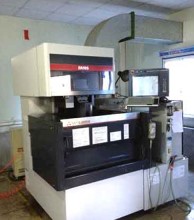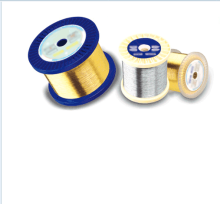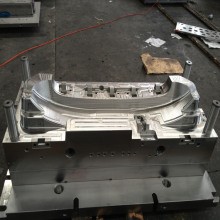Low speed wire cut,
also known as low-speed walking, uses continuous moving thin metal wires
(called electrode wires, generally copper wires) as electrodes to perform
pulsed spark discharge on the work piece, which generates high temperatures
above 6000 degrees, etc. A CNC machining machine that becomes a work piece. The principle of slow wire processing is the
phenomenon that there is a gap between the wire electrode and the work piece,
and the electrical discharge is continuously removed.
Walk slowly. Unlike CNC turning, which is suitable for processing Dowel Pins, Low
speed wire cut is more suitable for irregular workpieces that require
right-angle cutting.
Since the Low speed wire cut machine adopts the method of continuous wire feeding of the wire electrode, that is, the wire electrode completes the processing during the movement, so even if the wire electrode is worn, it can be continuously supplemented, which can improve the processing accuracy of the part. The surface roughness of the work piece processed by the slow-feed wire cutting machine can usually reach Ra = 0.8 μm and above, and the roundness error, straight line error and dimensional error of the slow-feed wire cutting machine are much better than those of the fast-feed wire cutting machine. For high-precision parts, Low speed wire cut machines are widely used. In addition to early small and medium-sized enterprises, it is also very common in processing plants of large enterprises such as aviation, automotive, and medical.
WORKING PRINCIPLE
Jog wire is a machining machine that uses continuous moving thin metal wires (called electrode wires) as electrodes to perform pulse spark discharge on the work piece to remove metal and cut and form. Loose contact light pressure discharge between the wire electrode and the work piece during slow wire processing. When the flexible electrode wire and the work piece are close to the commonly considered discharge gap (for example, 8 to 10 μm), spark discharge does not occur. Even when the electrode wire has contacted the work piece and the gap is no longer visible from the microscope, it is often not visible. To the spark, a normal spark discharge occurs only when the work piece bends the electrode wire and deviates a certain distance (a few microns to several tens of microns). At this time, for each 1 μm of wire electrode feed, the discharge gap does not decrease by 1 μm, but the electrode wire increases a little tension between the wires, and the work piece increases a little lateral pressure. Obviously, only after maintaining a slight contact pressure between the electrode wire and the work piece In order to form a spark discharge. Based on this, it is believed that there is some kind of electrochemically generated insulating film medium between the electrode wire and the work piece
Processing characteristics
Surface Quality
(1) Nanosecond high peak current pulse power technology
In the EDM process, there are two types of metal erosion: melting and gasification. The wide pulse width and long action time are easy to cause melting processing, make the work piece surface morphology worse, thicken the metamorphic layer, increase internal stress, and easily cause cracks. When the pulse width reaches a certain value, the action time is extremely short, and the gasification process is formed, which can reduce the thickness of the metamorphic layer, improve the surface quality, reduce internal stress, and avoid cracks.

The pulse power of the advanced low-speed wire-feed EDM wire cutting machine has a pulse width of only tens of ns and a peak current of more than 1 000 A. It forms gasification erosion, which not only has high processing efficiency, but also greatly improves the surface quality.
(2) Anti-electrolytic (BS) pulse power supply
Low-speed wire-wiring EDM uses water-based working fluid. Water has a certain electrical conductivity. Even after deionization treatment, the conductivity is reduced, but there is still a certain number of ions. When the work piece is connected to the positive electrode, under the action of the electric field, OH- ions will continue to accumulate on the work piece, causing oxidation and corrosion of iron, aluminum, copper, zinc, titanium, and tungsten, and causing the binder in the cemented carbide material to form cobalt. The ionic state is dissolved in water, forming a "softened layer" on the surface of the work piece. Measures have been adopted to increase the resistivity to reduce the ion concentration as much as possible. Although it has played a certain role in improving the surface quality, it still cannot be effectively and thoroughly solved. " Softening layer "problem.
Anti-electrolytic power is an effective technical means to solve the "softening layer" of the work piece. The anti-electrolytic power source uses alternating pulses with an average voltage of zero, which makes the OH-ion electrode wire in the working fluid oscillate with the work piece, does not tend to the work piece and the electrode wire, and prevents the work piece material from oxidizing.
The use of an anti-electrolytic power supply for EDM can control the surface metamorphic layer below 1 μm, avoid the precipitation and dissolution of cobalt in the cemented carbide material, and ensure the life of the cemented carbide mold.
Cutting accuracy

(1) Multiple cutting techniques
The multiple cutting technology is the fundamental means to improve the precision and surface quality of wire-cut EDM wire cutting at low speed. It is a scientific integration of design and manufacturing technology, numerical control technology, intelligent technology, pulse power technology, precision transmission and control technology. Generally, it is formed by one cutting, the accuracy is improved by two cutting, and the surface quality is improved by three or more cutting. In order to achieve a high-quality surface, the number of times of multiple cutting needs to be as high as 7 to 9, and only 3 to 4 times.
(2) Corner processing technology is continuously optimized
Due to the hysteresis of the electrode wire when cutting corners, the corners will collapse. To improve corner cutting accuracy, researchers have adopted more dynamic corner processing strategies. Such as: changing the wire path; changing the processing speed (thin plate); automatically adjusting the water pressure; controlling the processing energy, etc.
By adopting a comprehensive corner control strategy, the corner shape error during roughing can be reduced by 70%, and the fit accuracy can be cut up to 5 靘 at a time.
(3) Adopting technology to improve flatness
High-precision finishing circuits are technologies that improve flatness and are considered to be of great significance for thick parts processing.
(4) Machine tool structure is more precise
In order to ensure high-precision processing, many technical measures have been adopted to improve the accuracy of the host: ①Control the temperature. The water temperature cooling device is adopted to make the internal temperature of the machine tool the same as the water temperature and reduce the thermal deformation of the machine tool. ② Use linear motor. High responsiveness, precise positioning can achieve 0.1μm equivalent control, feed without vibration, noise, increase discharge frequency, maintain stable discharge, cut Ry5 μm twice. ③ The ceramic and polymer artificial granite parts are used, whose thermal inertia is 25 times greater than that of cast iron, which reduces the influence of temperature changes on cutting accuracy. ④ The fixed worktable and column moving structure are adopted to improve the load-bearing of the worktable without being affected by the immersion processing and the weight change of the work piece. ⑤Immersion processing is adopted to reduce the thermal deformation of the work piece. ⑥ Motor servo, closed loop electrode wire tension control. ⑦High-precision tool setting: using voltage modulation tool setting power. Tool setting accuracy can reach ± 0.005 mm without damaging the work piece, regardless of wet or dry.

Processing efficiency
1) Maximum processing efficiency
Due to the development of ns-level high-peak current pulse power supply technology and detection, control, and anti-interference technologies, the processing efficiency of low-speed wire-feed EDM wire cutting machines is also continuously improved.
(2) Machining efficiency of larger thickness work pieces
The machine tool purchased by Xiamen Zhonglida Machinery Processing Co., Ltd. can cut a work piece with a thickness of 300 mm, and the processing efficiency can reach 170 mm2 / min. This is a very practical technical improvement.
(3) Machining efficiency of work pieces with varying thickness
Automatically detect the thickness of the work piece and automatically adjust the processing parameters to prevent wire breaks and achieve the highest processing efficiency in this state.
(4) Double-wire automatic exchange technology
The ROBOFIL 2030S1-TW machine can automatically switch between two wires using electrode wires from 0.20 to 0.02 mm. Thick wire is used for the first cut, the general wire diameter is 0.25 mm to improve processing efficiency and coreless cutting; then fine wire is used for trimming, generally using 0.10 mm fine wire to cut small rounded corners, and Improve accuracy. The overall cutting time can be saved by 30% to 50%.
Scan to wechat:
